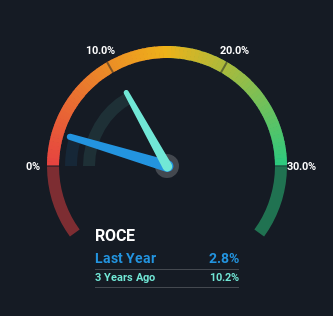Capital Allocation Trends At Zhejiang Chunhui Intelligent Control (SZSE:300943) Aren't Ideal
What trends should we look for it we want to identify stocks that can multiply in value over the long term? One common approach is to try and find a company with returns on capital employed (ROCE) that are increasing, in conjunction with a growing amount of capital employed. Basically this means that a company has profitable initiatives that it can continue to reinvest in, which is a trait of a compounding machine. Although, when we looked at Zhejiang Chunhui Intelligent Control (SZSE:300943), it didn't seem to tick all of these boxes.
What Is Return On Capital Employed (ROCE)?
For those who don't know, ROCE is a measure of a company's yearly pre-tax profit (its return), relative to the capital employed in the business. To calculate this metric for Zhejiang Chunhui Intelligent Control, this is the formula:
Return on Capital Employed = Earnings Before Interest and Tax (EBIT) ÷ (Total Assets - Current Liabilities)
0.028 = CN¥27m ÷ (CN¥1.2b - CN¥268m) (Based on the trailing twelve months to March 2024).
Thus, Zhejiang Chunhui Intelligent Control has an ROCE of 2.8%. Ultimately, that's a low return and it under-performs the Machinery industry average of 5.6%.
View our latest analysis for Zhejiang Chunhui Intelligent Control

Historical performance is a great place to start when researching a stock so above you can see the gauge for Zhejiang Chunhui Intelligent Control's ROCE against it's prior returns. If you're interested in investigating Zhejiang Chunhui Intelligent Control's past further, check out this free graph covering Zhejiang Chunhui Intelligent Control's past earnings, revenue and cash flow.
How Are Returns Trending?
On the surface, the trend of ROCE at Zhejiang Chunhui Intelligent Control doesn't inspire confidence. Around five years ago the returns on capital were 22%, but since then they've fallen to 2.8%. On the other hand, the company has been employing more capital without a corresponding improvement in sales in the last year, which could suggest these investments are longer term plays. It's worth keeping an eye on the company's earnings from here on to see if these investments do end up contributing to the bottom line.
On a side note, Zhejiang Chunhui Intelligent Control has done well to pay down its current liabilities to 22% of total assets. That could partly explain why the ROCE has dropped. Effectively this means their suppliers or short-term creditors are funding less of the business, which reduces some elements of risk. Some would claim this reduces the business' efficiency at generating ROCE since it is now funding more of the operations with its own money.
The Bottom Line
To conclude, we've found that Zhejiang Chunhui Intelligent Control is reinvesting in the business, but returns have been falling. And investors appear hesitant that the trends will pick up because the stock has fallen 35% in the last three years. On the whole, we aren't too inspired by the underlying trends and we think there may be better chances of finding a multi-bagger elsewhere.
Zhejiang Chunhui Intelligent Control does have some risks though, and we've spotted 3 warning signs for Zhejiang Chunhui Intelligent Control that you might be interested in.
While Zhejiang Chunhui Intelligent Control may not currently earn the highest returns, we've compiled a list of companies that currently earn more than 25% return on equity. Check out this free list here.
Valuation is complex, but we're here to simplify it.
Discover if Zhejiang Chunhui Intelligent Control might be undervalued or overvalued with our detailed analysis, featuring fair value estimates, potential risks, dividends, insider trades, and its financial condition.
Access Free AnalysisHave feedback on this article? Concerned about the content? Get in touch with us directly. Alternatively, email editorial-team (at) simplywallst.com.
This article by Simply Wall St is general in nature. We provide commentary based on historical data and analyst forecasts only using an unbiased methodology and our articles are not intended to be financial advice. It does not constitute a recommendation to buy or sell any stock, and does not take account of your objectives, or your financial situation. We aim to bring you long-term focused analysis driven by fundamental data. Note that our analysis may not factor in the latest price-sensitive company announcements or qualitative material. Simply Wall St has no position in any stocks mentioned.
Have feedback on this article? Concerned about the content? Get in touch with us directly. Alternatively, email editorial-team@simplywallst.com
About SZSE:300943
Zhejiang Chunhui Intelligent Control
Zhejiang Chunhui Intelligent Control Co., Ltd.
Excellent balance sheet second-rate dividend payer.
Market Insights
Community Narratives





